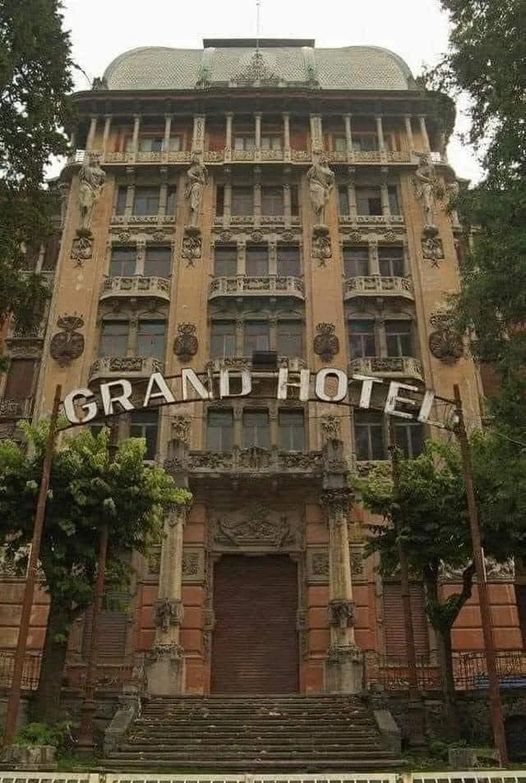The Grand Hotel of San Pellegrino: The €18 Million Restoration
The Grand Hotel of San Pellegrino in San Pellegrino Terme, Italy, is a striking example of how careful and thoughtful restoration can revive the glamour of a once-glorious luxury destination. After an €18 million restoration, this grand hotel, which has been abandoned for decades, has been reborn as a luxurious, historically rich, and stunning property, blending its past grandeur with modern amenities.
History and Significance of the Grand Hotel of San Pellegrino
Built between 1904 and 1907, the Grand Hotel of San Pellegrino was an architectural masterpiece of the early 20th century. Located in the San Pellegrino Terme region of Lombardy, Italy, the hotel was once a symbol of luxury and sophistication, attracting high society, wealthy guests, and European aristocracy. The town of San Pellegrino Terme itself was well-known for its thermal spas and beautiful natural surroundings, making the Grand Hotel a sought-after destination for wellness and leisure.
The building was designed by architect Romolo Squadrelli, a well-known Italian architect of the time, and it featured a Liberty-style (Italian Art Nouveau) architectural design, marked by its elegant use of curves, ornate detailing, and stunning period-specific décor. The hotel’s majestic appearance and setting by the Brembo River helped to solidify its reputation as a premier spa destination in Europe.
In its heyday, the hotel hosted many famous guests, including royalty, artists, and cultural figures. The hotel’s luxurious amenities, including grand ballrooms, fine dining restaurants, and thermal water treatments, offered an unparalleled experience for visitors.
However, like many grand hotels from this period, the Grand Hotel of San Pellegrino fell into disrepair after World War II and eventually became abandoned by the early 1980s. Despite its historical significance, the hotel had remained empty for years, with parts of the building falling into ruin.
The €18 Million Restoration: Bringing Back the Glory
In 2018, the Italian government, local authorities, and private investors launched an ambitious restoration project aimed at preserving and reviving the Grand Hotel of San Pellegrino. The €18 million restoration was designed to restore the hotel’s original charm and grandeur, while incorporating modern amenities and improving the infrastructure. The restoration was not only an attempt to breathe new life into the property but also to return it to its former place as a symbol of Italian luxury and elegance.
The project took several years, with efforts focused on both preserving the architectural integrity and updating the facilities to meet current standards of luxury hospitality. Here’s a breakdown of some key aspects of the restoration:
Architectural Restoration and Preservation
Facade and Exterior: One of the key elements of the restoration was the painstaking work to restore the building’s exterior façade, which had suffered from years of neglect. The ornate Liberty-style details were carefully restored to their original beauty, with delicate craftsmanship applied to the intricate stucco, window frames, and balustrades.
Roofs and Structural Work: The roof was carefully restored, with work done to reinforce the structure and prevent further damage. Sections of the building’s roof that had deteriorated were rebuilt using materials that closely matched the originals to maintain historical accuracy.

Window and Door Restoration: The windows, doors, and shutters were refurbished, with attention to preserving the original wooden frames and glass designs, many of which feature beautiful stained glass.
Interior Restoration: Opulence Meets Modern Comfort
The interior of the Grand Hotel was carefully restored to reflect the original grandeur of its 1900s design, while updating its spaces for modern use.
Ballrooms and Public Spaces: The ballroom, once a site for elaborate social gatherings, was restored to its full glory with restored frescoes, crystal chandeliers, and marble columns. The ballroom, a symbol of the hotel’s former opulence, retains its period-appropriate detailing, including the intricate ceiling work and grand archways.
Guest Rooms and Suites: The hotel’s guest rooms were updated with modern luxury, incorporating state-of-the-art amenities while maintaining the historical charm of the building. The rooms have a mix of Art Nouveau design elements alongside contemporary comforts like modern lighting, heating, and air conditioning systems.
Thermal Spas and Wellness: The hotel has long been associated with the town’s famous thermal waters, and this aspect was central to the restoration. The original thermal baths and wellness areas were revamped to provide modern spa treatments, blending traditional Italian wellness practices with the latest in luxury spa design.
Modern Amenities and Sustainable Upgrades
While much of the focus was on preserving the original aesthetics, the restoration also brought modern amenities to the hotel, ensuring it meets the needs of 21st-century visitors. Key upgrades included:
Energy-Efficient Systems: Sustainable building practices were integrated into the restoration, with new energy-efficient heating, cooling, and insulation systems installed to minimize energy consumption.
Updated Infrastructure: Plumbing, electrical, and safety systems were completely modernized. Wi-Fi, modern lighting, and security systems were seamlessly integrated into the design, ensuring the hotel meets the standards of luxury travelers.
Accessibility: Efforts were made to make the hotel accessible to all guests, with elevators and improved pathways to accommodate those with mobility challenges.
Restoring the Grand Hotel’s Iconic Features
The Grand Hall: One of the most iconic aspects of the hotel is its Grand Hall, a vast, open space with high ceilings, elegant arches, and beautifully tiled floors. This space, which once held social events and gatherings, was restored to preserve its luxurious character and to serve as a central gathering place for guests.
The Terrace with View of the River: The hotel’s terraces overlooking the Brembo River were restored, offering guests a peaceful place to relax and take in the natural beauty of the surrounding landscape. The terraces were carefully preserved, ensuring that the views remain as stunning as they were when the hotel first opened.
Celebrating Local History and Culture
The restoration project also involved efforts to celebrate the local culture and the historical significance of the area. The hotel’s location in the San Pellegrino Terme region is known for its rich tradition of mineral springs and wellness tourism. As part of the restoration, there was an emphasis on incorporating the local culture and natural beauty into the guest experience, with outdoor spaces and areas that connect visitors to the stunning surrounding landscapes.
The Grand Hotel’s Future as a Luxury Destination
After completing the restoration, the Grand Hotel of San Pellegrino has officially re-opened its doors as a luxury hotel and spa, offering a unique blend of historical charm and modern luxury. The building is now a prime destination for travelers seeking both wellness and history, with luxurious accommodations, fine dining, and access to the healing thermal waters that made San Pellegrino famous.
The restoration has also led to an increase in tourism and local investment, with many hoping that the revived hotel will become a focal point for travelers interested in exploring Italy’s hidden gems. The hotel’s restoration is also part of a larger movement to preserve the architectural and cultural heritage of Italy, with historical buildings like the Grand Hotel being revitalized and re-imagined for contemporary use.
In Summary
The €18 million restoration of the Grand Hotel of San Pellegrino has successfully brought this historic masterpiece back to life, preserving its Liberty-style beauty and grandeur while incorporating modern comforts and sustainable updates. Now, it stands as a luxurious wellness retreat that celebrates the past, the thermal heritage of San Pellegrino Terme, and Italy’s rich architectural history.
For anyone seeking an authentic and luxurious experience with a rich historical backdrop, this hotel has become a new symbol of Italian elegance and charm.

